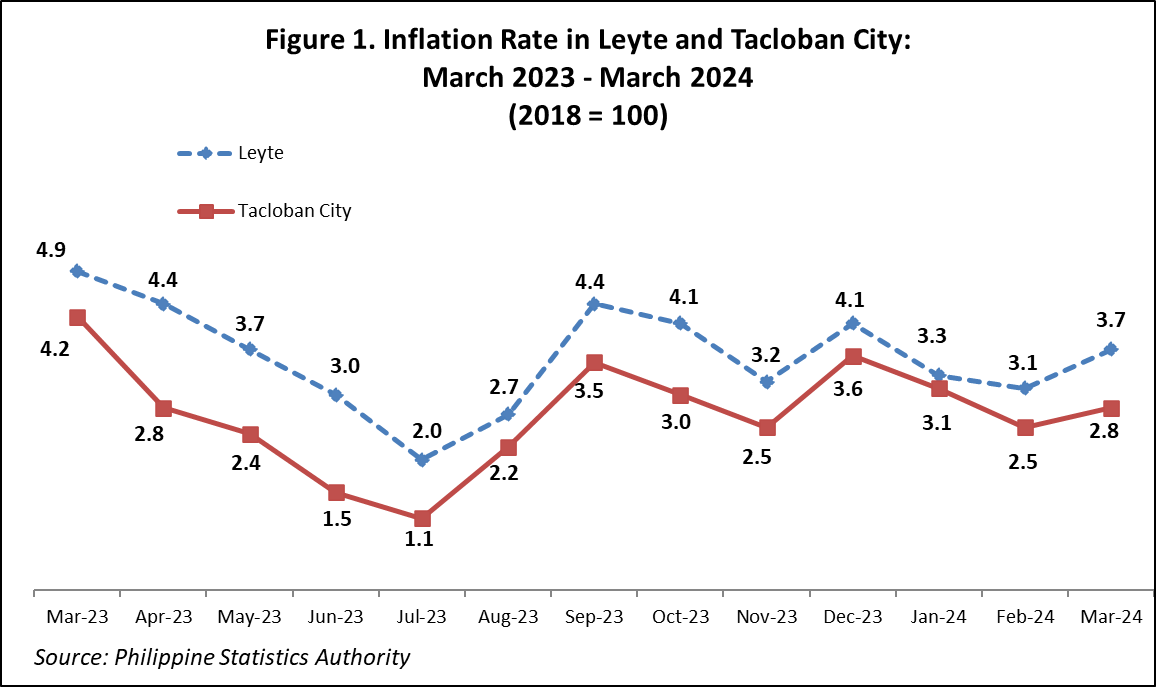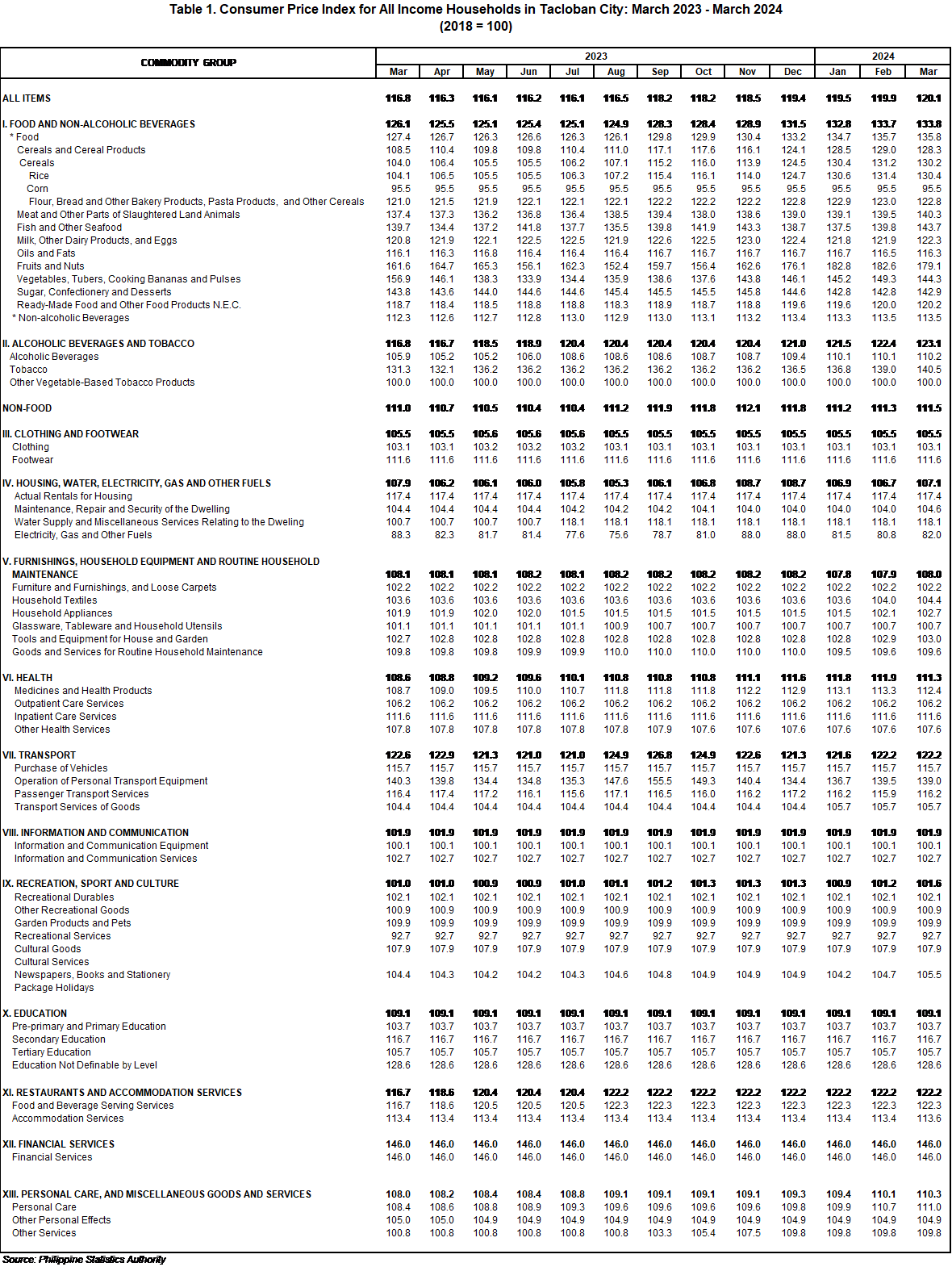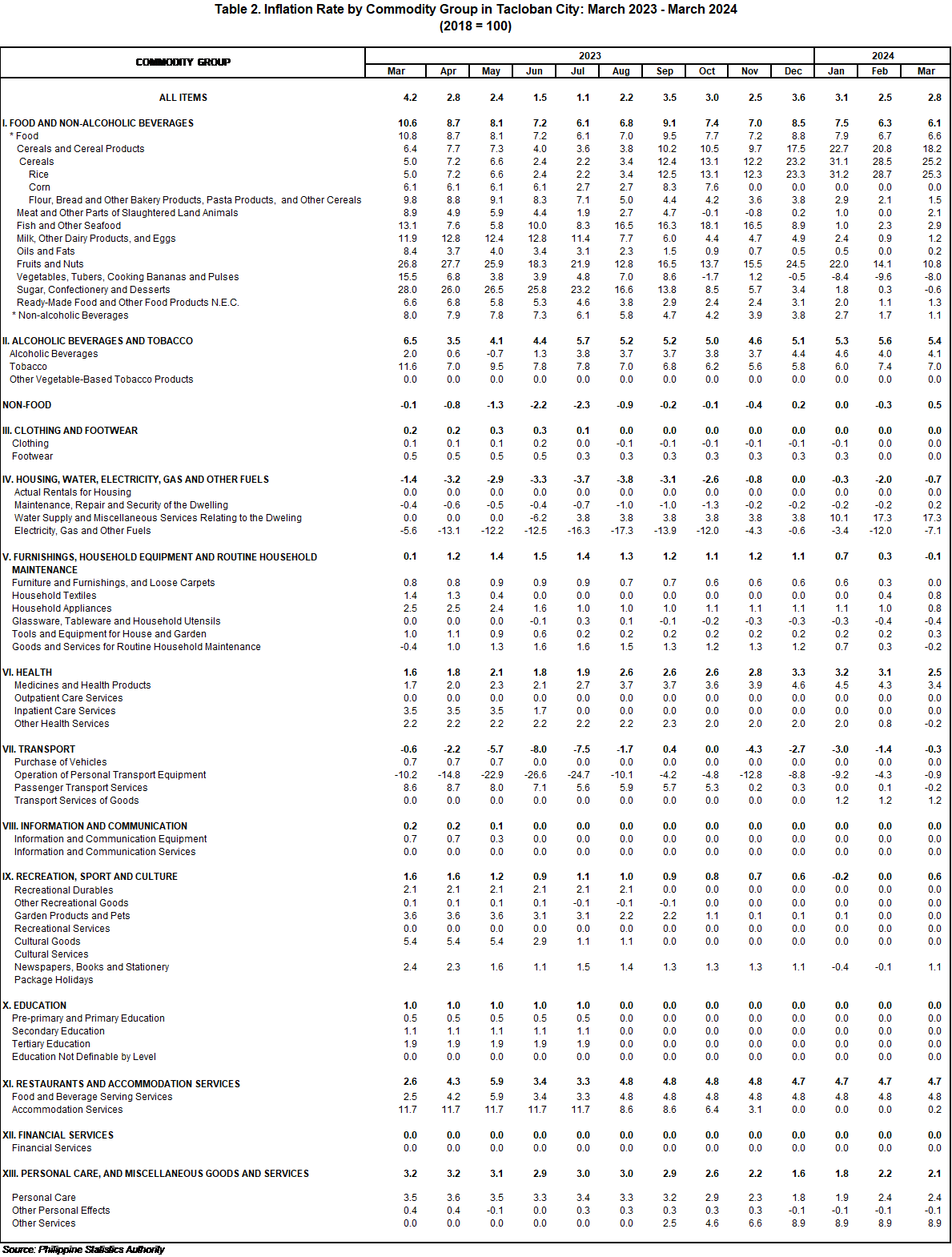Tacloban City’s inflation slightly increases at 2.8 percent in March 2024
Tacloban City’s inflation rate slightly increased at 2.8 percent in March 2024 from 2.5 percent in February 2024. In March 2023, the inflation rate was higher at 4.2 percent. Likewise, Leyte’s inflation rate increased in March 2024 at 3.7 percent from 3.1 percent in February 2024. Among the provinces and HUC in the region, only Leyte, Southern Leyte, and Tacloban City manifested an increase in their respective inflation rates for the reference month.

Main Drivers and Top Three Commodity Groups Contributing to the Upward Trend of Tacloban City’s Inflation
The following commodity groups emerged as the main drivers to the upward trend in the March 2024 inflation rate of Tacloban City. They also emerged as the major contributors to the overall trend inflation of Leyte during the month-in-review:
a. Housing, water, electricity, gas and other fuels with 69.3 percent share, at -0.7 percent deflation during the month from -2.0 percent deflation in the previous month which was caused by the increase in prices of security equipment and materials for the maintenance and repair of the dwelling, the slower rate of decrease in prices of electricity and liquid fuels, and the faster rate of increase in prices of gas;
b. Transport with 29.3 percent share, at -0.3 percent deflation during the month from -1.4 percent deflation in the previous month due to the slower rate of decrease in prices of fuels and lubricants for personal transport equipment; and
c. Recreation, sport and culture with 1.5 percent share, at 0.6 percent inflation during the month from zero percent in the previous month which was driven by the increase in prices of stationery and drawing materials.
In contrast, the following commodity groups recorded a decrease in their respective inflation rates in March 2024:
a. Food and non-alcoholic beverages at 6.1 percent from 6.3 percent which was driven by the slower rate of increase in prices of cereals and cereal products, fruits and nuts, fruit and vegetable juices, coffee and coffee substitutes, cocoa drinks, and soft drinks, and the decrease in prices of sugar, confectionery and desserts;
b. Alcoholic beverages and tobacco at 5.4 percent from 5.6 percent due to the slower rate of increase in prices of tobacco;
c. Health at 2.5 percent from 3.1 percent which was caused by the slower rate of increase in prices of medicines and medical products, and the decrease in prices of diagnostic imaging services and medical laboratory services; and
d. Personal care, and miscellaneous goods and services at 2.1 percent from 2.2 percent due to the slower rate of increase in prices of hairdressing salons and personal grooming establishments.
On the other hand, furnishings, household equipment and routine household maintenance recorded a deflation of -0.1 percent during the month from an inflation of 0.3 percent in the previous month which was driven by the slower rate of increase in prices of furniture, furnishings and loose carpets, and the decrease in prices of small household appliances and domestic services and household services.
Meanwhile, the other five (5) major commodity groups maintained their inflation rates from their previous months’ rate:
a. Clothing and footwear at zero percent;
b. Information and communication also at zero percent;
c. Education services also at zero percent;
d. Financial services also at zero percent; and
e. Restaurants and accommodation services at 4.7 percent.
The inflation rate is the general rise in prices over a period. It indicates how fast or how slow price changes over two-time periods. Contrary to common knowledge, low inflation does not necessarily connote that prices are falling instead; it means that prices continue to increase at a slower rate. It is a derived indicator of the Consumer Price Index (CPI).
The CPI is a measure of change in the average retail prices of goods and services commonly purchased by a particular group of people in a specific area. The overall CPI in Tacloban City for March 2024 was 120.1. This implies that the average retail price of goods and services in Tacloban City is 20.1 percent higher than the average retail prices in 2018 (base year).
Purchasing Power of Peso (PPP) retains at 83 centavos in March 2024
The Purchasing Power of Peso (PPP) in Tacloban City retained at 83 centavos in March 2024. Likewise, the PPP in Leyte retained at 81 centavos during the reference month. The 83 centavos purchasing power of peso in Tacloban City indicates that the same basket of goods and services worth 83 pesos in 2018 (base year) is worth 100 pesos during the reference period.



TECHNICAL NOTES
Rebasing of the CPI is necessary to ensure that this barometer of economic phenomena is truly reflective of current situation. Consumer taste, fashion and technology change over time causing the fixed market basket of goods and services to become outmoded. To capture such changes for a more meaningful price comparison, revision or updating of the fixed market basket, the sample outlets, the weights and the base year had to be done periodically.
BASE PERIOD - refers to the reference period of the index number. It is a period at which the index is set to 100. Current base period is 2018.
COMPUTING THE CPI - The formula used in computing the CPI is the weighted arithmetic mean of price relatives, a variant of the Laspeyres formula with fixed base year period weights.
CONSUMER PRICE INDEX - is a measure of change in the average retail prices of goods and services commonly purchased by a particular group of people in a particular area.
INFLATION RATE - refers to the annual rate of change or year-on-year change in CPI.
MARKET BASKET - refers to a sample of goods and services used to represent all goods and services bought by a particular group of consumers in a particular area.
MONITORING OF PRICES - is to establish baseline information for prices of the items in the base year and monitoring of the prices of the items on a regular basis. Except for Food, Beverage and Tobacco which is monitored on a weekly basis in NCR, price collection is done twice a month. First collection phase is done during the first five days of the month while the second phase is on the 15th to 17th day of the month.
PURCHASING POWER PESO - it is a measure of how much the peso in the base period is worth in another period. It gives as indication of the real value in a given period relative to the peso value in the base period.
RETAIL PRICE - refers to the actual price at which retailers sell a commodity on spot or earliest delivery, usually in small quantities for consumption and not for resale. It is confined to transactions on cash basis in the free market and excludes black-market prices and prices of commodities that are on sale as in summer sales, anniversary sales, Christmas sales, etc.
WEIGHTS - The weights for the 2018-based CPI were derived from the expenditure data of the 2018 Family Income and Expenditure Survey (FIES). The weight for each item of expenditure is a proportion of that expenditure item to the total national expenditure. The total (all items) national expenditure weights is equal to 100.
SGD. SHERYL ANN A. JAMISOLA
Chief Statistical Specialist

